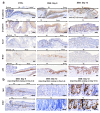Anorectal Remodeling in the Transitional Zone with Increased Expression of LGR5, SOX9, SOX2, and Keratin 13 and 5 in a Dextran Sodium Sulfate-Induced Mouse Model of Ulcerative Colitis
- PMID: 39684417
- PMCID: PMC11640979
- DOI: 10.3390/ijms252312706
Anorectal Remodeling in the Transitional Zone with Increased Expression of LGR5, SOX9, SOX2, and Keratin 13 and 5 in a Dextran Sodium Sulfate-Induced Mouse Model of Ulcerative Colitis
Abstract
Although hyperplasia of the anorectal transitional zone (TZ) has been reported in mouse models of ulcerative colitis, the mechanisms underlying this phenomenon are not fully understood. We characterized keratin subtypes and examined the expression of stem cell markers in the TZ. Dextran sodium sulfate-treated mice showed abnormal repair of the anorectal region, which consisted of mixed hyperplastic TZ and regenerating crypts. Liquid chromatography-tandem mass spectrometry from the paraffin-embedded TZ in the treated mice revealed that the major keratins were type I cytokeratin (CK)13 and type II CK5, but notable expression of type I CK10 and CK42 and type II CK1, CK4, CK6a, CK8, and CK15 was also detected. Hyperplastic TZ was characterized by the expression of tumor protein 63, sex-determining region Y-box 2 (SOX2), SOX9, and leucine-rich repeat-containing G-protein coupled receptor 5 (Lgr5). Lgr5 was highly expressed in the TZ in the early stages of colitis, followed by higher expression levels of SOX2. The TZ-derived organoids expressed LGR5, SOX2, and SOX9. The present study suggests that transitional zones showing abnormal keratin assembly and stem cell activation may interfere with rectal crypt regeneration, leading to pathological anorectal remodeling in severe colitis.
Keywords: LGR5; SOX2; SOX9; mouse; transitional zone; ulcerative colitis.
Conflict of interest statement
The authors declare no conflicts of interest.
Figures






Similar articles
-
NHE8 Deficiency Promotes Colitis-Associated Cancer in Mice via Expansion of Lgr5-Expressing Cells.Cell Mol Gastroenterol Hepatol. 2018 Aug 24;7(1):19-31. doi: 10.1016/j.jcmgh.2018.08.005. eCollection 2019. Cell Mol Gastroenterol Hepatol. 2018. PMID: 30465020 Free PMC article.
-
Ectopically Localized Epithelial Cell Clumps in Ulcers Are Derived from Reserved Crypt Stem Cells in a Mouse Model of Ulcerative Colitis.Dig Dis Sci. 2022 Oct;67(10):4770-4779. doi: 10.1007/s10620-021-07340-4. Epub 2022 Jan 28. Dig Dis Sci. 2022. PMID: 35088188
-
Lhx2 differentially regulates Sox9, Tcf4 and Lgr5 in hair follicle stem cells to promote epidermal regeneration after injury.Development. 2011 Nov;138(22):4843-52. doi: 10.1242/dev.070284. Development. 2011. PMID: 22028024 Free PMC article.
-
Expression of epidermal stem cell markers in skin and adnexal malignancies.Br J Dermatol. 2016 Sep;175(3):520-30. doi: 10.1111/bjd.14494. Epub 2016 Jul 27. Br J Dermatol. 2016. PMID: 26914519
-
Molecular regulation mechanism of intestinal stem cells in mucosal injury and repair in ulcerative colitis.World J Gastroenterol. 2023 Apr 28;29(16):2380-2396. doi: 10.3748/wjg.v29.i16.2380. World J Gastroenterol. 2023. PMID: 37179583 Free PMC article. Review.
Cited by
-
Establishment of a bat lung organoid culture model for studying bat-derived infectious diseases.Sci Rep. 2025 Feb 3;15(1):4035. doi: 10.1038/s41598-025-88621-0. Sci Rep. 2025. PMID: 39900611 Free PMC article.
-
Generation and characterization of feline colorectal adenocarcinoma organoids as a preclinical model.J Vet Med Sci. 2025 Jul 1;87(7):752-762. doi: 10.1292/jvms.24-0499. Epub 2025 Apr 30. J Vet Med Sci. 2025. PMID: 40301072 Free PMC article.
References
-
- Yang E.J., Quick M.C., Hanamornroongruang S., Lai K., Doyle L.A., McKeon F.D., Xian W., Crum C.P., Herfs M. Microanatomy of the cervical and anorectal squamocolumnar junctions: A proposed model for anatomical differences in HPV-related cancer risk. Mod. Pathol. 2015;28:994–1000. doi: 10.1038/modpathol.2015.54. - DOI - PMC - PubMed
-
- Moshi J.M., Hoogduin K.J., Ummelen M., Henfling M.E.R., van Engeland M., Wouters K.A.D., Stoop H., Demers I., Looijenga L.H.J., Ramaekers F.C.S., et al. Switches of SOX17 and SOX2 expression in the development of squamous metaplasia and squamous intraepithelial lesions of the uterine cervix. Cancer Med. 2020;9:6330–6343. doi: 10.1002/cam4.3201. - DOI - PMC - PubMed
MeSH terms
Substances
Grants and funding
LinkOut - more resources
Full Text Sources
Medical
Molecular Biology Databases
Research Materials

